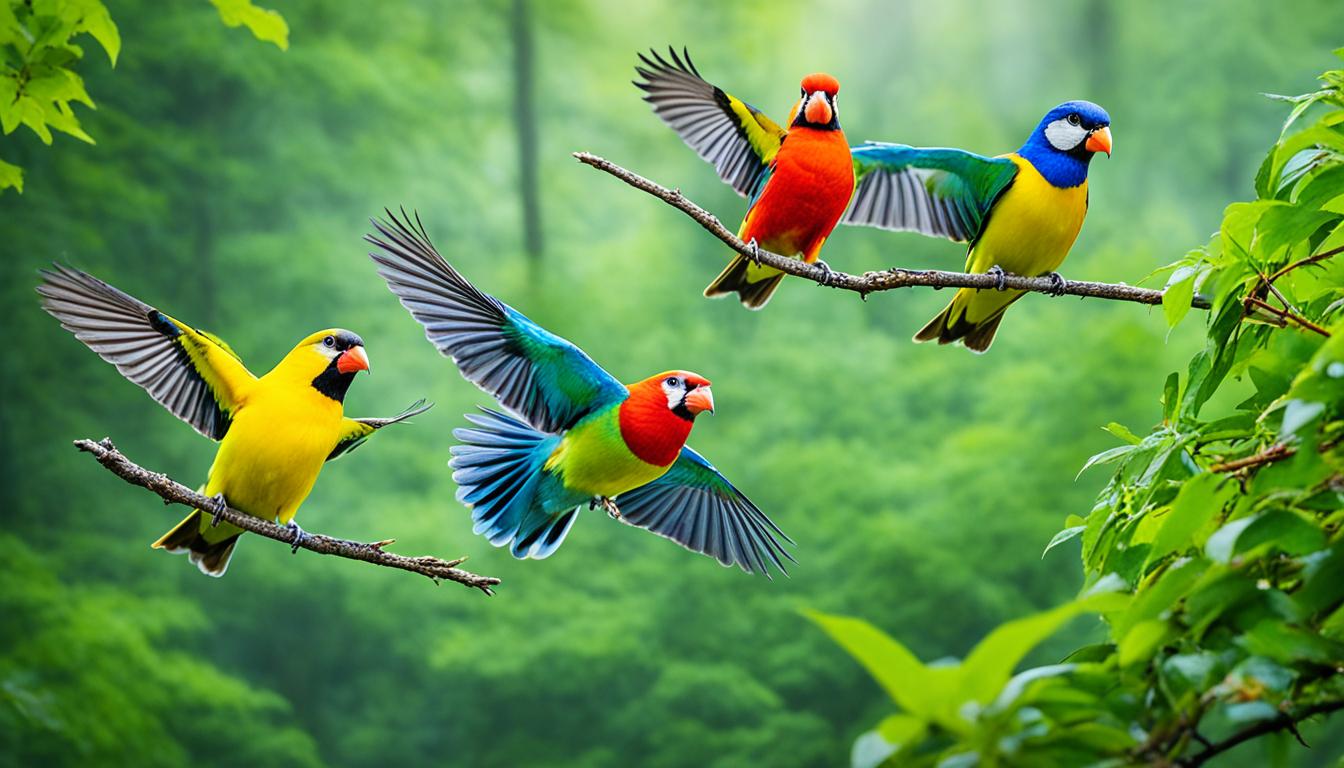Many animals migrate in groups to boost their survival and efficiency. Traveling together enhances safety from predators, as larger groups confuse threats and reduce individual risk. You'll also see improved navigation, thanks to social cues and shared knowledge. Plus, collective foraging increases access to nutrition-rich areas. With all these benefits, it's no wonder animals prefer to travel in groups. Discover more about the fascinating behaviors of migratory species and their unique strategies.
Key Takeaways
- Group migration enhances safety from predators by confusing them and utilizing the "dilution effect," reducing individual risk.
- Animals benefit from improved navigation efficiency through social cues and shared knowledge within the group.
- Collective movement allows for better foraging success as individuals can access nutrient-rich areas more effectively.
- Synchronized migration fosters learning of migratory behaviors, especially for inexperienced individuals observing knowledgeable members.
- Larger groups facilitate increased reproductive success by enhancing mate finding and improving overall survival strategies.
The Benefits of Group Migration
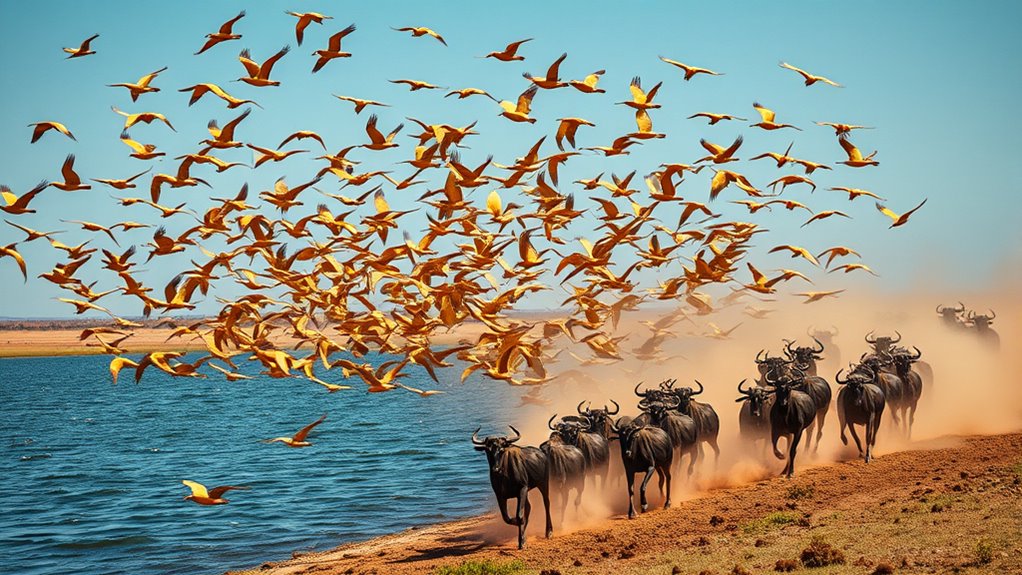
When animals migrate in groups, they considerably boost their chances of survival. Group migration enhances collective vigilance, allowing individuals to watch for predators, which reduces the risk for each member during the journey.
By traveling together, animals can also navigate more efficiently, relying on social cues and shared knowledge to find ideal routes. The social aspects of migration foster learning, as you'll observe individuals picking up valuable migratory behaviors from one another.
Additionally, synchronized movement means you can save energy by slipstreaming, making the journey less taxing. Group migration also increases reproductive success, as larger congregations make it easier for individuals to find mates during breeding seasons.
Social Interactions and Information Exchange
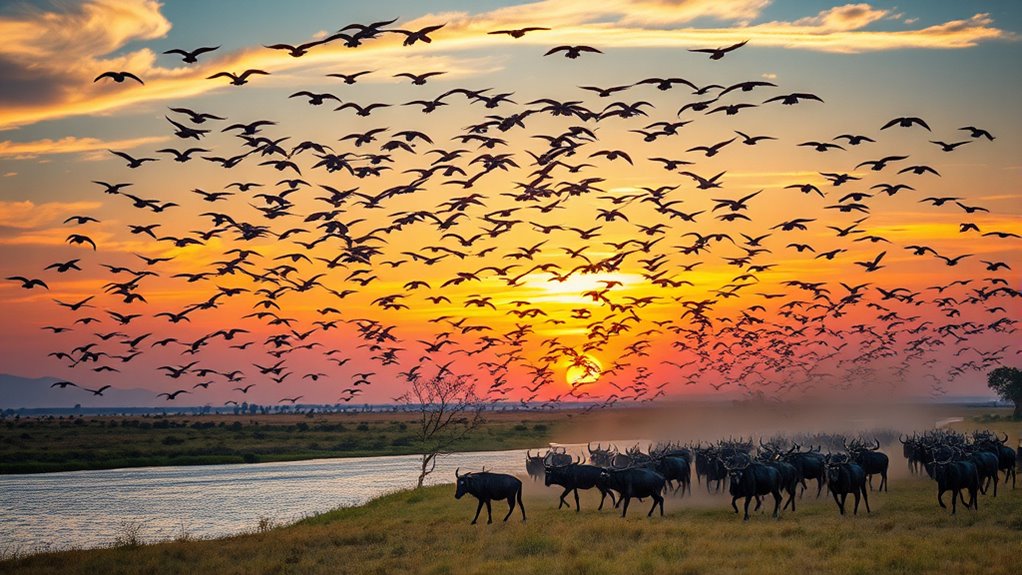
As animals migrate together, they rely on social interactions to share essential information that enhances their journey. These social cues help individuals learn from each other about ideal routes and environmental conditions.
For instance, species like wildebeests and zebras exhibit synchronized movements, which not only improves navigation but also offers safety in numbers against predators. Limited time for exploration due to seasonal changes drives this collective behavior.
In addition, advances in tracking technologies show how migratory blue whales communicate through vocalizations and social signals, effectively coordinating their movements.
Navigation in Migratory Groups

When you think about migratory animals, consider how they use social cues from their peers to find their way.
By moving in sync with others, they not only enhance efficiency but also bolster safety during their journey.
Observing group dynamics helps them navigate unfamiliar landscapes more effectively, showcasing the power of collective movement.
Social Cues Utilization
Migratory animals often rely on social cues to navigate their journeys effectively, enhancing their chances of survival. By observing and responding to social information, these animals can make more informed decisions during migration.
For instance, species like migratory blue whales use distant vocalizations to orient themselves, showcasing the power of auditory cues. Group dynamics play an essential role, as individuals benefit from the collective knowledge shared within their groups. This exchange of information helps reduce risks and improves efficiency in unfamiliar landscapes.
With advances in tracking technologies, researchers uncover the intricate patterns of interaction among animals that migrate, revealing how social cues shape their migratory behavior and bolster their survival strategies.
Group Movement Synchronization
Maneuvering in groups offers migratory animals significant advantages, particularly through synchronized movement. When you observe these animals during migration, you'll notice how their coordinated actions enhance navigation efficiency.
By syncing their movements, they can make collective decisions that reduce risks in unfamiliar environments. Social cues like vocalizations or visual signals help maintain this coordination, allowing individuals to follow leaders or stay close together.
Research shows that such synchronization improves the accuracy of migratory routes, as each member benefits from the group's shared knowledge. Additionally, collective movement mitigates predation risks; there's safety in numbers.
Environmental factors, such as wind patterns and food availability, influence this synchronization, leading to coordinated departures and arrivals among the animals.
Navigation Techniques in Groups
How do animals navigate effectively during migration as a group? Migratory animals rely on social cues like movements and vocalizations to enhance their travel. By observing their peers, they tap into collective knowledge about routes and landmarks, improving navigation accuracy.
For instance, birds often form V-shaped flocks, reducing wind resistance and making it easier to stay on course. Inexperienced individuals learn from more knowledgeable members, gaining valuable insights into the journey ahead.
Research using GPS tracking shows that these groups synchronize their movements based on environmental cues and the behavior of others. This collaborative approach not only aids in navigation but also boosts the overall success of the migration, ensuring that the entire group reaches its destination effectively.
Protection Against Predators

When animals travel in groups, they gain a significant advantage in protecting themselves from predators. Migrating together allows them to benefit from safety in numbers, confusing and overwhelming their attackers.
For instance, wildebeests and zebras often migrate in herds, minimizing their risk of predation by distracting lions and other hunters. This is where the "dilution effect" comes into play; the larger the group, the lower the chance that any single individual will be targeted.
Additionally, synchronized movements enhance group cohesion, making it easier for everyone to spot threats. Species like salmon also rely on larger schools during migration, using their collective size to navigate safely and avoid predators as they journey to their spawning grounds.
Foraging Efficiency in Collective Movement
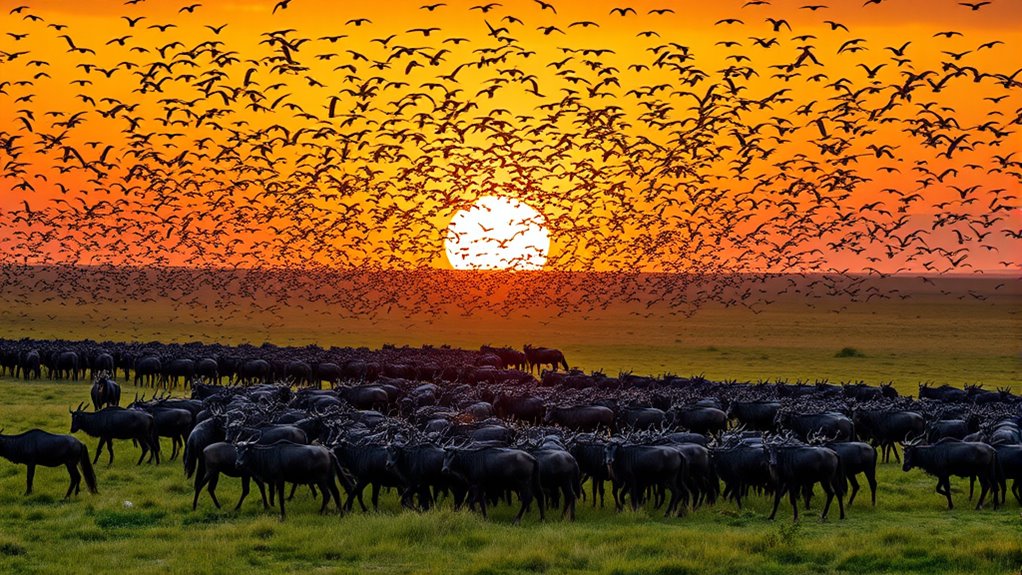
When animals migrate in groups, they greatly boost their chances of finding food.
You'll notice that their collective movement cuts down search time and enhances food discovery.
Enhanced Food Discovery
Migrating in groups greatly boosts foraging efficiency, as animals can quickly share essential information about food sources. When animals travel together, they can cover larger areas, increasing their chances to find food.
By observing experienced individuals, less experienced members can learn the best foraging strategies, saving time and energy. This social foraging behavior helps maximize overall energy intake, allowing the group to thrive.
Group migration also leads to synchronized feeding opportunities, where many animals exploit a food source at once, enhancing the benefits for everyone involved.
Species like wildebeests and zebras exemplify this, as their collective presence not only deters predators but also grants them better access to rich grasslands, ensuring they stay nourished during migration.
Reduced Search Time
Collective movement greatly cuts down the time animals spend searching for food, as they can quickly tap into the foraging successes of their companions. When animals migrate together, they effectively share information about food sources. This social behavior considerably boosts foraging efficiency, allowing groups to locate food 30% faster than solitary individuals.
| Advantage | Explanation |
|---|---|
| Reduced Search Time | Groups locate food quicker through shared success |
| Enhanced Foraging Efficiency | Synchronization minimizes energy expenditure |
| Information Sharing | Animals communicate food locations |
| Survival Boost | Maximizes food intake during migration |
Cooperative Foraging Strategies
Effective foraging strategies emerge as animals migrate together, allowing them to exploit food resources more successfully. Cooperative foraging strategies enhance foraging efficiency by enabling individuals to locate food more effectively when moving as a group.
With collective vigilance, you'll notice increased prey capture rates, reducing predation risk and improving survival during migration. Species like wildebeests and zebras showcase synchronized movements, maximizing access to grasslands and showcasing the benefits of foraging in nutrient-rich areas.
Social learning plays an essential role; inexperienced members can observe and follow knowledgeable individuals, enhancing their foraging success.
Additionally, collective movement helps share information about food availability and ideal foraging sites, ultimately shaping migration patterns and maximizing nutritional intake for all involved.
Case Studies of Group Migration in Animals
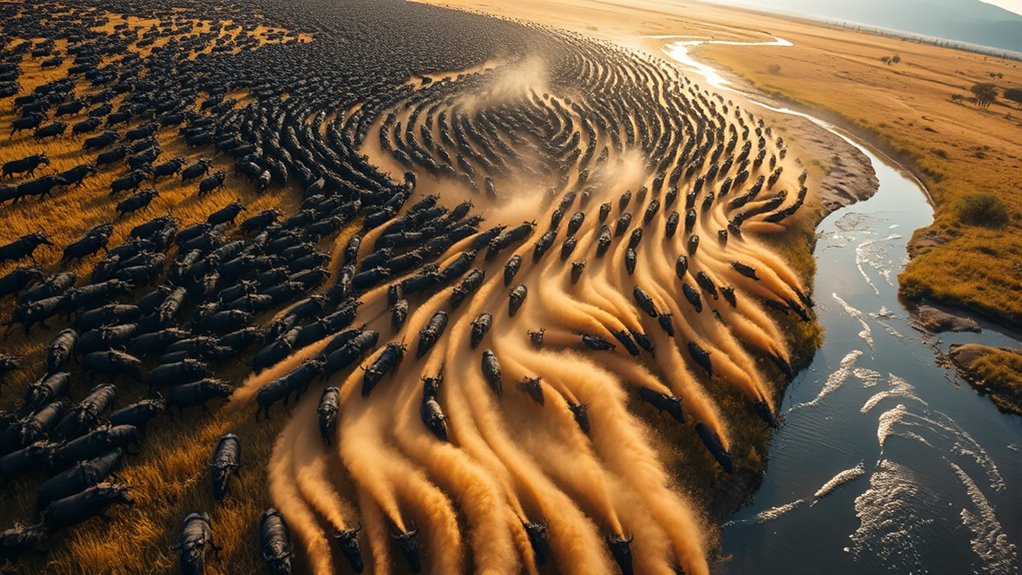
While many animals commence long journeys to find food or breeding grounds, those that migrate in groups often enjoy significant advantages.
For instance, wildebeests and zebras in Tanzania's Serengeti migrate in large groups, enhancing their safety against predators. Humpback whales form pods to improve foraging efficiency, corralling fish for easier feeding.
Monarch butterflies demonstrate collective navigation during their synchronous migration from Canada to Mexico, boosting survival rates. Salmon migrate in schools, using group dynamics to navigate rivers and evade predators.
Additionally, Christmas Island red crabs migrate en masse to the ocean for reproduction, showcasing how collective movement guarantees successful breeding while minimizing predation risk.
These case studies illustrate the myriad benefits of group migration across species.
Frequently Asked Questions
Why Do Animals Migrate in Groups?
Animals migrate in groups for several reasons.
You'll notice that larger groups provide safety in numbers, making them less vulnerable to predators. By sticking together, they can share valuable information about food sources and ideal routes, enhancing their survival.
You might observe social cues, where younger or inexperienced animals follow leaders, ensuring they navigate correctly.
Plus, migrating together can increase reproductive success, as finding mates and suitable breeding sites becomes easier.
What Are the Reasons for Animal Migration?
You might think it's just about food, but animal migration's got a lot more going on!
When harsh weather hits or resources dwindle, animals instinctively search for better habitats. Reproductive needs also play a big role; some species travel to specific breeding grounds to guarantee their young thrive.
Plus, migrating can reduce encounters with predators and diseases, boosting survival rates.
Why Do Some Animals Migrate and Some Don T?
Some animals migrate to find better resources, escape harsh conditions, or reproduce in safer areas, while others stay put due to a stable environment or sufficient resources.
You might notice that social species often travel together, whereas solitary ones rely on their individual strategies.
Factors like food availability, climate, and social structures play a huge role in these decisions, shaping whether an animal decides to move with others or remain in its territory.
Why Do Animals Like to Move in Groups?
Animals like to move in groups for several reasons.
You'll notice that being in a larger group offers safety in numbers, helping to deter predators. When you travel with others, you can share knowledge about food sources and navigation routes, making the journey more efficient.
Plus, group movement allows for synchronized responses to environmental changes, enhancing survival.
Ultimately, social bonds formed in groups can lead to better reproductive opportunities during migrations.
Conclusion
To sum up, migrating in groups offers animals a treasure trove of benefits. From enhanced social interactions and shared navigation skills to increased safety from predators, collective movement is a smart survival strategy. Just like a crew of pirates sailing the high seas, these animals rely on teamwork to find food and reach their destinations. So next time you see a flock in the sky, remember they're not just traveling; they're making the journey easier and safer together.



